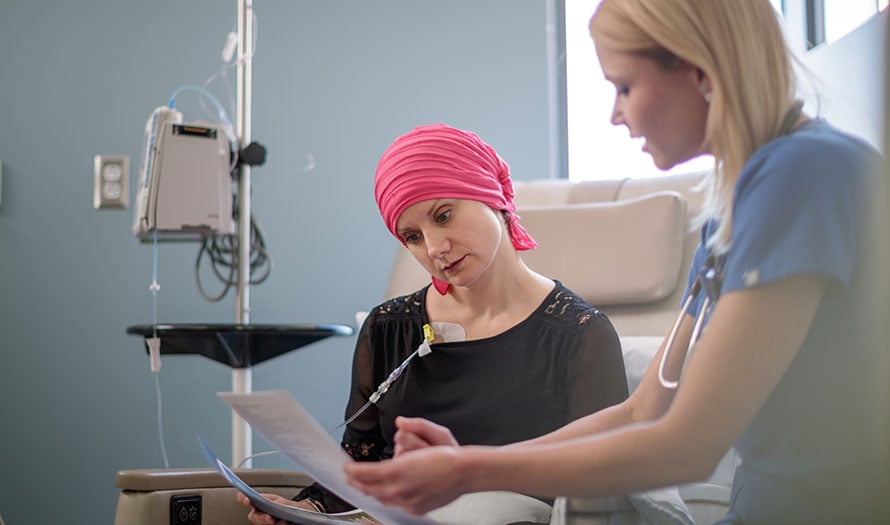Chemotherapy

A key characteristic of most types of cancer is uncontrolled cell growth, which creates an abundance of excess cells that bind together and form tumors. Chemotherapy is a common cancer treatment that capitalizes on this behavior. Specifically, chemo involves the use of powerful drugs that target rapidly dividing cells, interfering with their ability to grow and ultimately destroying them. As such, it can be highly effective in fighting cancer.
Chemotherapy may be used as a standalone treatment or in combination with other cancer therapies, such as surgery, radiation therapy and targeted therapy. Chemo medications may be swallowed in pill form or injected into a vein. In some cases, the drugs are placed directly inside or near a tumor during surgery.
What does chemotherapy involve?
After being administered orally or intravenously, chemotherapy medications enter the bloodstream and circulate throughout the body to reach widespread cancer cells. Typically, the drugs are given at regular intervals (cycles). Each cycle may include several consecutive days of treatment followed by several weeks of rest. The number of cycles in a chemotherapy regimen and the total time it takes to complete the regimen can vary depending on the medications used and other factors. This cyclic approach to treatment is designed to provide the body with sufficient time to recover and create healthy new cells.
What happens during chemotherapy?
Chemotherapy may be administered in a hospital, outpatient infusion center or physician’s office, though some oral chemotherapy drugs can be taken at home as directed by a physician. During an in-office chemotherapy session, a healthcare professional will generally:
- Assess and record the patient’s vital signs, including blood pressure, pulse, body temperature and respiration rate
- Insert a soft, flexible intravenous (IV) line into a vein in the patient’s arm or hand (unless the patient has a pre-existing catheter or port)
- Draw a blood sample to check the patient’s blood counts
- Conduct a brief physical exam
- Determine and order the precise medication dose needed based on the patient’s height, weight and other factors
- Administer fluids to ensure proper hydration
- Provide pre-chemotherapy medications as needed to prevent nausea and allergic reactions
- Begin the infusion process, which may take several hours
- Remove the IV line (if applicable) when the treatment is complete and recheck the patient’s heart rate, blood pressure and breathing
- Discuss potential side effects and offer guidance on how to manage them
Many patients choose to wear loose, warm clothing to each chemo session. To improve comfort and help pass the time, some patients bring personal items, such as a sweater, socks, blanket, refillable water bottle, books, journal, sketchpad, needlework, headphones and a laptop/tablet with movies, podcasts, audiobooks or music.
What are the risks and possible complications of chemotherapy?
Chemotherapy can effectively halt the growth of rapidly dividing cells, such as cancer cells. However, some healthy cells within the body are naturally fast-growing, including the cells in the hair follicles, bone marrow, mouth lining and digestive tract. Chemo can also interfere with the growth of these cells, possibly leading to side effects. Usually, chemo side effects can be effectively managed and will resolve after treatment is completed.
Common short-term side effects of chemotherapy include:
- Fatigue
- Hair loss
- Reduced appetite
- Nausea and vomiting
- Gastrointestinal distress and diarrhea
- Mouth sores
- Skin irritation and nail changes
- Nerve damage (neuropathy)
- Heightened risk of infection
- Impaired cognitive function (“chemo brain”)
What to expect during recovery from chemotherapy
Once the chemotherapy regimen is complete, any side effects should gradually improve and resolve within approximately 12 months, although the weakness and fatigue may last longer. During regular follow-up appointments with the physician, the patient will receive personalized guidance on how to regain their strength and resume their normal activities. The physician will continually monitor the patient’s progress, watching for long-term side effects and signs of cancer recurrence.
How effective is chemotherapy?
Chemotherapy can be highly effective in treating various types of cancer, particularly when used as part of a comprehensive treatment plan. For instance, when administered before surgery, chemo can shrink a tumor and make it easier to remove. When administered after surgery, it can target and destroy any remaining microscopic cancer cells and reduce the risk of recurrence.
As a systemic treatment, chemotherapy can be particularly beneficial for treating metastatic tumors. That said, its effectiveness can vary based on factors such as the type and stage of cancer, the specific drugs used and the patient’s overall health.
Benefit from world-class care at Moffitt Cancer Center
Moffitt takes a highly individualized approach to chemotherapy. After completing a thorough evaluation, our multispecialty team can determine the specific drug or drug combination that offers the most promise for your specific diagnosis.
We provide outpatient chemotherapy at these convenient locations:
- The Infusion Center at the Magnolia campus (main campus)
- Moffitt Cancer Center at International Plaza
- Richard M. Schulze Family Foundation Outpatient Center at the McKinley campus
- Moffitt Cancer Center at Wesley Chapel
We also perform blood and platelet transfusions, IV antibiotics, pump disconnections, blood draws and other related services.
After determining the optimal schedule for your chemotherapy infusions, our team can help you schedule your appointments at the location that works best for you. We can also tell you more about the patient experience at Moffitt.
If you would like to learn more about chemotherapy, you can request an appointment with a specialist at Moffitt by calling 1-888-663-3488 or submitting a new patient registration form online. We do not require referrals.
Helpful Videos:
Ports for Chemo and Other Uses: Overview and Placement
Ports for Chemo and Other Uses: Access and Care
Basics of Chemotherapy and Immunotherapy
What is a Peripherally Inserted Catheter?
